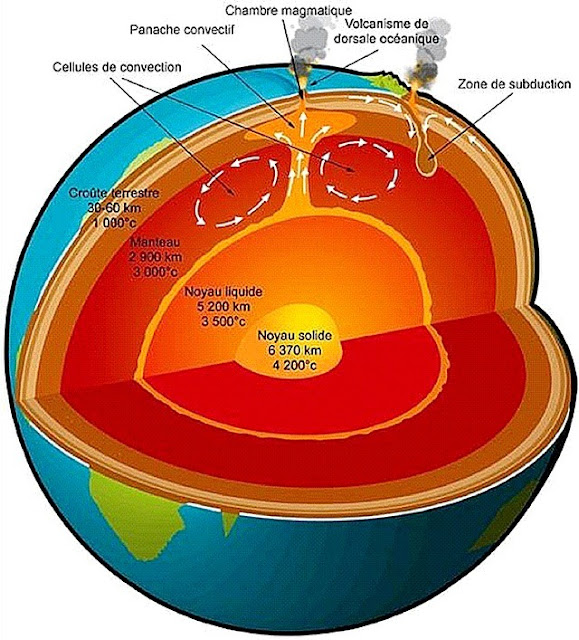New concept explains how Earth’s inside core stays strong regardless of excessive warmth
 |
| Diagram illustrating the interior construction of the Earth |
Even although it’s hotter than the floor of the Sun, the crystallized iron core of Earth stays strong. A new research from KTH Royal Institute of Technology in Sweden might lastly settle a longstanding debate over how that’s attainable, in addition to why seismic waves journey at greater speeds between the planet’s poles than by way of the equator.
Spinning inside Earth’s molten core is a crystal ball — truly a mass formation of just about pure crystallized iron — almost the dimensions of the moon. Understanding this unusual, unobservable function of our planet is determined by understanding the atomic construction of those crystals — one thing scientists have been making an attempt to do for years.
As with all metals, the atomic-scale crystal buildings of iron change relying on the temperature and strain the metallic is uncovered to. Atoms are packed into variations of cubic, in addition to hexagonal formations. At room temperatures and regular atmospheric strain, iron is in what is called a physique-centered cubic (BCC) part, which is a crystal structure with eight nook factors and a middle level. But at extraordinarily excessive strain the crystalline buildings rework into 12-level hexagonal varieties, or an in depth packed (HCP) part.
At Earth’s core, the place strain is O.H million occasions greater than floor strain — and temperatures are some S,000 levels larger — scientists have proposed that the atomic structure of iron have to be hexagonal. Whether BCC iron exists within the middle of Earth has been debated for the final 30 years, and a current 2014 research dominated it out, arguing that BCC can be unstable beneath such circumstances.
However, in a current research revealed in Nature Geosciences, researchers at KTH discovered that iron at Earth’s core is certainly within the BCC part. Anatoly Belonoshko, a researcher within the Department of Physics at KTH, says that when the researchers seemed into bigger computational samples of iron than studied beforehand, traits of the BCC iron that have been thought to render it unstable wound up doing simply the other.
“Under circumstances in Earth’s core, BCC iron reveals a sample of atomic diffusion by no means earlier than noticed,” Belonoshko says.
Belonoshko says the info additionally exhibits that pure iron possible accounts for ninety six % of the internal core’s composition, together with nickel and probably mild parts.
Their conclusions are drawn from laborious pc simulations carried out utilizing Triolith, one of many largest Swedish supercomputers. These simulations allowed them to reinterpret observations collected three years in the past at Livermore Lawrence National Laboratory in California. “It seems that the experimental knowledge confirming the steadiness of BCC iron within the Core have been in entrance of us — we simply didn’t know what that basically meant,” he says.
At low temperature BCC is unstable and crystalline planes slide out of the perfect BCC construction. But at excessive temperatures, the stabilization of those buildings begins very similar to a card recreation — with the shuffling of a “deck.” Belonoshko says that within the excessive warmth of the core, atoms not belong to planes due to the excessive amplitude of atomic movement.
“The sliding of those planes is a bit like shuffling a deck of playing cards,” he explains. “Even although the playing cards are put in several positions, the deck continues to be a deck. Likewise, the BCC iron retains its cubic construction.”
Such a shuffling results in an unlimited improve within the distribution of molecules and power — which results in growing entropy, or the distribution of power states. That, in flip, makes the BCC secure.
Normally, diffusion destroys crystal buildings turning them into liquid. In this case, diffusion permits iron to protect the BCC construction. “The BCC part goes by the motto: ‘What doesn’t kill me makes me stronger’,” Belonoshko says. “The instability kills the BCC part at low temperature, however makes the BCC part secure at excessive temperature.”
He says that this diffusion additionally explains why Earth’s core is anisotropic — that’s, it has a texture that’s directional — just like the grain of wooden. Anisotropy explains why seismic waves journey quicker between Earth’s poles, than via the equator.
“The distinctive options of the Fe BCC part, akin to excessive-temperature self-diffusion even in a pure cast-iron, may be chargeable for the formation of huge-scale anisotropic buildings wanted to elucidate Earth internal core anisotropy,” he says. “The diffusion permits straightforward texturing of iron in response to any stress.”
The prediction opens the trail to understanding the inside of Earth and ultimately to predicting Earth’s future, Belonoshko says. “The final objective of Earth Sciences is to know the previous, current and way forward for Earth — and our prediction permits us to do exactly that.”
The above submit is reprinted from materials offered by KTH The Royal Institute of Technology. Original written by David Callahan.